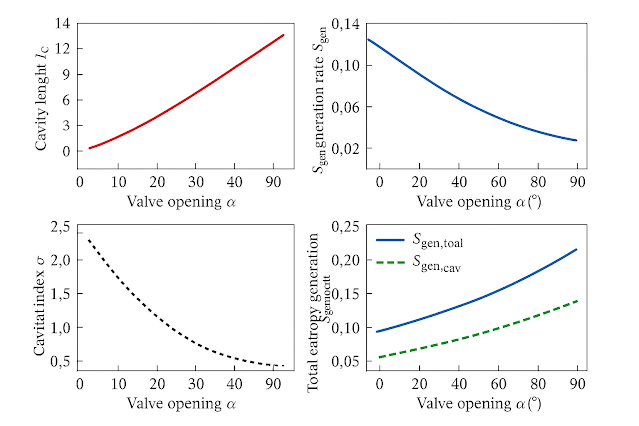Modified Cavitation Modeling and Entropy-Based Analysis of Cryogenic Ball Valve Performance
Introduction
Cryogenic valves are vital components in the operation of low-temperature fluid systems, particularly those handling liquefied gases such as LNG (liquefied natural gas), LN₂ (liquid nitrogen), and LO₂ (liquid oxygen). These valves ensure the precise control, safety, and reliability of fluid transmission in various industrial and scientific applications. However, under cryogenic conditions, cavitation—caused by local vaporization and subsequent collapse of fluid—poses a significant threat to system integrity. This phenomenon leads to vibration, noise, and serious erosion of valve components, thereby compromising system performance. Understanding the cavitation behavior specific to cryogenic environments is essential for improving valve design and ensuring reliable operation. The present study addresses these challenges by modifying an existing cavitation model to better reflect the thermodynamic effects unique to cryogenic fluids.
Development of a Cryogenic Cavitation Model
To accurately simulate and predict cavitation in cryogenic conditions, the study enhances the conventional Zwart–Gerber–Belamri (ZGB) cavitation model by incorporating the thermodynamic effects of cryogenic fluids. Traditional cavitation models often fail to account for the sharp changes in temperature and pressure characteristics of cryogenic liquids, which are critical to understanding vapor bubble formation and collapse. By embedding thermodynamic parameters into the original ZGB framework, the modified model achieves better alignment with the unique phase-change behavior observed in cryogenic fluids. This advancement lays the groundwork for more precise numerical simulations, offering researchers and engineers a more reliable tool for predicting cavitation risks in cryogenic valves.
Experimental and Simulation Validation
The credibility of the newly developed cavitation model is reinforced through a hybrid approach combining experimental observation with numerical simulation. Experiments were conducted to visualize cavitation phenomena at different valve openings and flow conditions, capturing key parameters such as pressure fluctuations, flow instability, and noise levels. Simultaneously, computational fluid dynamics (CFD) simulations using the modified model were carried out to replicate these scenarios. The close agreement between experimental results and simulation outputs validates the model's applicability and reliability in real-world settings. This dual-validation method ensures that the model can be confidently used to predict cavitation behavior in cryogenic systems under varying operating conditions.
Nomination & Contact Details
Visit: cryogenicist.com
Nomination Link: https://cryogenicist.com/award-nomination/?ecategory=Awards&rcategory=Awardee
Contact: support@cryogenicist.com
Influence of Valve Opening on Cavitation Behavior
One of the critical aspects investigated in this study is the impact of different valve openings on cavitation intensity and flow control performance. It was observed that larger valve openings significantly amplify cavitation effects, leading to greater flow instability and energy loss. At smaller openings, the restricted passage suppresses cavitation to some extent but may introduce pressure drops and control difficulties. The research highlights that cavitation volume, vortex formation, and turbulence characteristics are strongly dependent on the valve’s operational state. This finding provides valuable insights for optimizing valve control strategies and designing cavitation-resistant valves tailored to specific operating ranges.
Vortex Structures and Cavitation Evolution
The study also delves into the spatial and temporal characteristics of vortex structures that accompany cavitation development in cryogenic valves. These vortices, formed due to rapid phase transitions and fluid acceleration, are closely tied to the nucleation and collapse of vapor cavities. High-resolution flow field analysis reveals that the dynamics of vortices correspond strongly with the growth and decay cycles of cavitation, forming a predictive basis for monitoring and controlling cavitation evolution. By mapping the interactions between vortex structures and cavitation zones, the research enhances our understanding of internal valve dynamics and informs future valve design methodologies.
Entropy-Based Energy Loss Analysis
To quantify the energy loss caused by cavitation, the study adopts an entropy production characterization method. This approach distinguishes between direct dissipation (EPDD) and turbulent dissipation (EPTD), both of which contribute significantly to the total entropy generated within the cavitating flow field. Results indicate that the spool outlet region is the main site of entropy accumulation, signaling high energy dissipation and performance degradation. This entropy-based analysis not only quantifies the efficiency losses due to cavitation but also provides a framework for diagnosing and mitigating cavitation-induced damage in cryogenic systems. Understanding the entropy production profile allows for the identification of hotspots and supports the development of more energy-efficient valve systems.

Comments
Post a Comment